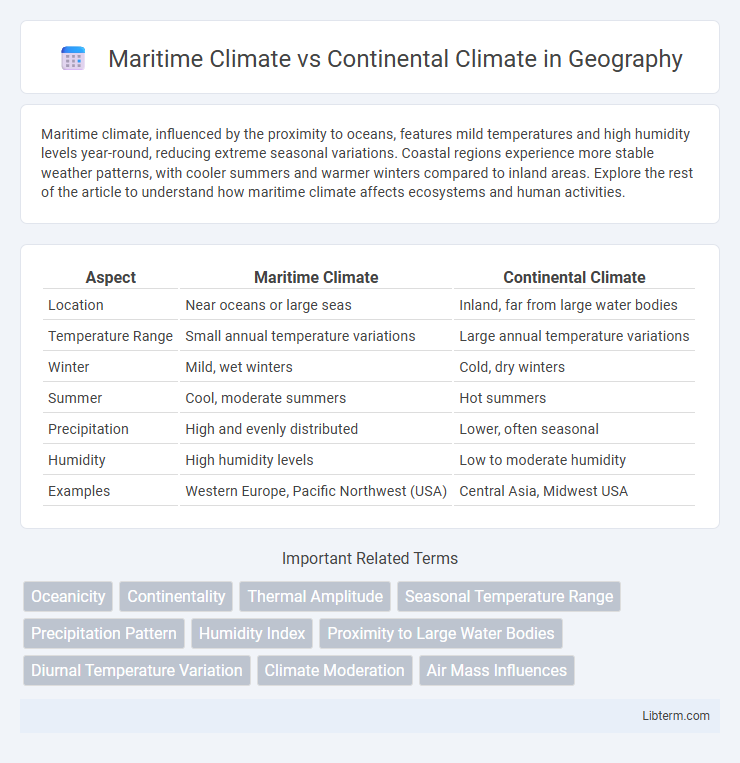Maritime climate, influenced by the proximity to oceans, features mild temperatures and high humidity levels year-round, reducing extreme seasonal variations. Coastal regions experience more stable weather patterns, with cooler summers and warmer winters compared to inland areas. Explore the rest of the article to understand how maritime climate affects ecosystems and human activities.
Table of Comparison
| Aspect | Maritime Climate | Continental Climate |
|---|---|---|
| Location | Near oceans or large seas | Inland, far from large water bodies |
| Temperature Range | Small annual temperature variations | Large annual temperature variations |
| Winter | Mild, wet winters | Cold, dry winters |
| Summer | Cool, moderate summers | Hot summers |
| Precipitation | High and evenly distributed | Lower, often seasonal |
| Humidity | High humidity levels | Low to moderate humidity |
| Examples | Western Europe, Pacific Northwest (USA) | Central Asia, Midwest USA |
Introduction to Maritime and Continental Climates
Maritime climates, found along coastlines, exhibit moderate temperatures due to the ocean's thermal inertia, resulting in cooler summers and milder winters compared to inland areas. Continental climates, typical of interior landmasses far from large water bodies, experience more extreme temperature variations with hot summers and cold winters. These climatic differences stem from the contrasting heat capacities of water and land, influencing weather patterns and seasonal temperature fluctuations.
Defining Maritime Climate: Key Characteristics
Maritime climate is characterized by mild temperatures with narrow temperature ranges between seasons due to the moderating influence of large bodies of water. High humidity levels and frequent precipitation, often evenly distributed throughout the year, are typical features driven by oceanic moisture. Coastal areas with maritime climate experience cooler summers and milder winters compared to inland regions.
Understanding Continental Climate: Main Features
Continental climate is characterized by significant temperature variations between seasons, with hot summers and cold winters due to its location inland, away from the moderating influence of large water bodies. Precipitation levels tend to be lower and less evenly distributed throughout the year compared to maritime climates, often resulting in drier conditions. This climate type supports distinct seasonal changes in flora and fauna adapted to harsh temperature extremes and limited moisture availability.
Geographic Distribution of Maritime and Continental Climates
Maritime climates are predominantly found along western coastal regions of continents, such as the Pacific Northwest of North America and Western Europe, where oceanic influence moderates temperature fluctuations. Continental climates occur mainly in the interiors of large landmasses like Siberia, central Canada, and parts of Central Asia, characterized by significant temperature extremes due to the distance from oceanic bodies. The geographic distribution of these climates is heavily influenced by proximity to oceans, prevailing winds, and topographical barriers that affect heat retention and moisture availability.
Temperature Variability: Maritime vs Continental Zones
Maritime climates exhibit low temperature variability due to the moderating influence of large bodies of water, resulting in milder winters and cooler summers. Continental climates experience high temperature variability with more extreme seasonal temperature differences, characterized by hot summers and cold winters. Coastal regions in maritime zones generally maintain temperatures within a narrow range compared to the wide fluctuations seen in inland continental regions.
Precipitation Patterns in Both Climate Types
Maritime climates experience relatively consistent precipitation throughout the year due to the proximity to large bodies of water, resulting in moderate rainfall spread across seasons. Continental climates exhibit more variable precipitation patterns, often with distinct wet and dry periods, as inland locations lack the moisture regulation provided by oceans. These differences influence vegetation and water resource availability, with maritime regions supporting lush, stable ecosystems compared to more seasonal, drought-prone continental areas.
Seasonal Changes: Contrasts and Similarities
Maritime climates experience moderate seasonal changes with mild winters and cool summers due to the ocean's thermal regulation, while continental climates exhibit more extreme seasonal variations with hot summers and cold winters caused by the absence of large water bodies. Both climates undergo four distinct seasons, but maritime regions maintain more stable temperatures throughout the year. Precipitation patterns also differ, as maritime climates receive consistent rainfall year-round, whereas continental climates may have more pronounced seasonal precipitation shifts.
Impact on Local Ecosystems and Biodiversity
Maritime climates, characterized by moderate temperatures and high humidity, support diverse ecosystems with rich biodiversity due to stable conditions and abundant precipitation. Continental climates experience greater temperature extremes and lower humidity, resulting in ecosystems adapted to seasonal stress and often lower species diversity. These climatic differences influence plant phenology, animal behavior, and habitat availability, shaping the unique biodiversity patterns in coastal versus inland regions.
Human Adaptation and Economic Implications
Maritime climates, characterized by mild temperatures and high humidity, enable humans to adapt with lighter clothing and reduced heating costs, promoting energy efficiency. In contrast, continental climates experience extreme temperature variations, necessitating robust housing insulation and increased expenditure on heating and cooling systems. Economically, maritime regions benefit from longer growing seasons and stable agricultural yields, while continental zones face challenges in crop production volatility and higher infrastructure maintenance costs due to temperature extremes.
Future Trends: Climate Change Effects on Maritime and Continental Climates
Rising global temperatures intensify the differences between maritime and continental climates, with maritime regions experiencing milder winters and increased humidity, while continental areas face more extreme temperature fluctuations and drier conditions. Sea level rise and warmer oceans amplify storm severity and precipitation patterns in coastal zones, intensifying maritime climate impacts. Continental climates may encounter heightened heatwaves and drought frequency, challenging agriculture and water resources management.
Maritime Climate Infographic

 libterm.com
libterm.com